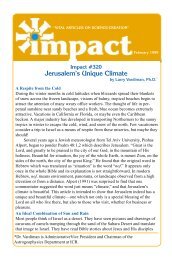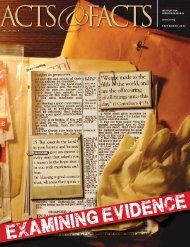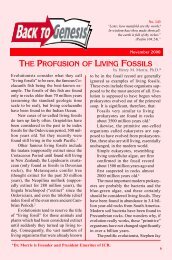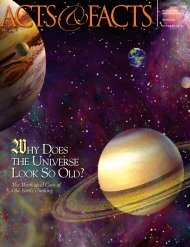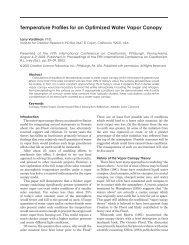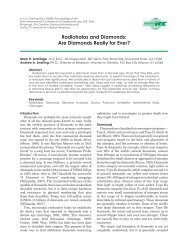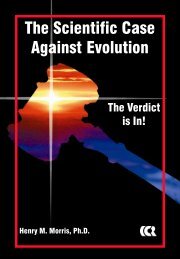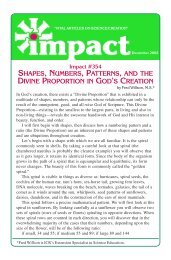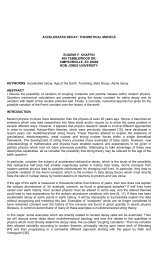IMPACTArber’s <strong>Research</strong> on EvolutionFor his study of mutations, Arber selectedbacteria because they have short generationtimes (20 minutes vs. 20 years <strong>for</strong> humans) andthere<strong>for</strong>e reproduce enormous numbers ofprogeny in only a few days. <strong>The</strong>y also do nothave sophisticated genetic repair mechanismsas do eukaryotes, allowing far more mutationsto be expressed in their offspring. One of Arber’sstudies evaluated 10,000 generations ofE. coli under various conditions, finding that“tremendous diversity accumulated withineach population.” 11 <strong>The</strong> phenotypic changewas very rapid <strong>for</strong> the initial 2,000 generations,but far slower <strong>for</strong> the subsequent 8,000generations, con<strong>for</strong>ming to the research onviruses that found the rate of fitness gain “deceleratedsignificantly over time,” as did the rateof nucleotide substitution. 11 Arber concludedthat genetic variety has definite limits, a findingcarefully documented by Behe. 7Most evolutionists believe that mutationsprovide the raw material <strong>for</strong> natural selection,and that these two mechanisms are thebasis <strong>for</strong> everything from the molecular machineryof the cell to the entire history of life onearth. Contrary to this belief, Behe found thatthe effect of these mechanisms on bacteria canexplain only marginal changes, and would account<strong>for</strong> very little of the basic machinery oflife and the variety of life existing today.In a review of the available researchfindings, Arber concluded that “bacteria usein parallel three qualitatively distinct naturalstrategies to obtain genetic variations.” 12 <strong>The</strong>sestrategies are 1) the acquisition of genetic in<strong>for</strong>mationoriginating from another organismby horizontal gene transfer, 2) recombinationrearrangements of DNA, and 3) small localchanges in the genome nucleotide sequence. 13Arber added that designed, genetically-encodedenzymes largely influence these rearrangements.<strong>The</strong>se enzymes function either as generatorsof genetic diversity, or as modulators ofthe frequency of genetic variation.This evidence indicates that the changeshe observed in bacteria resulted almost solelyfrom transposition and other types of chromosomalrearrangement, not mutations asrequired by macroevolution. 11 This study providesclear evidence that the putative evolutionobserved in microorganisms is primarily,if not totally, a result of built-in mechanismsdesigned to produce genetic, and thus phenotypic,variety.<strong>The</strong> steady implementation of these systems,together with non-genetic factors such as<strong>The</strong> claim that “more intensiveresearch is needed to understandthe apparent complexityof nature” is actuallyan admission of ignoranceabout the origin of complexityin the living natural world.external mutagens, cause genetic variation ofmicrobial populations and, by inference, geneticvariation in other populations. 12 We knowthis because similar genetic systems designedto produce genetic variety are also present inhigher organisms. <strong>The</strong>y likely have influencedthe past adaptations of these organisms andcontinue to play a role in causing minor geneticalterations.ConclusionsArber concluded that the genetic mechanismsthat produce variation are designedand are not products of Darwinian evolution.Furthermore, this variation—often calledmicroevolution—has clear limits and is unableto produce macroevolution. Arber stressedthat the knowledge of the “molecular basis ofbiological evolution” impacts not only “ourworldview” in the areas of origins, but also hasimplications <strong>for</strong> the possible risks of geneticengineering. 12 It is <strong>for</strong> this reason that Arber affirmedthat only the existence of a Creator Godis a satisfactory solution to the problem of biologicalorigins. 3References1. Speech by Peter Reichard, quoted in Arber, W, D. Nathans,and H. O. Smith. 1992. 1978 Physiology or Medicine. InJ. Lindsten (ed.), Nobel Lectures: Physiology or Medicine1971-1980. River Ridge, NJ: World Scientific Publishing,471-473.2. Schlessinger, B. and J. A. Schlessinger. 1986. <strong>The</strong> Who’s Whoof Nobel Prize Winners. Oryx Press: Phoenix, AZ.3. Arber, W. 1992. <strong>The</strong> Existence of a Creator Represents aSatisfactory Solution. In Margenau, H. and R. A. Varghese(eds.), Cosmos, Bios, <strong>The</strong>os: Scientists Reflect on Science,God, and the Origins of the Universe, Life, and Homo sapiens.La Salle, IL: Open Court, 141-143.4. Arber, W. 1979. Werner Arber: <strong>The</strong> Nobel Prize in Physiologyor Medicine 1978 Autobiography. In Odelberg, W.(ed.), <strong>The</strong> Nobel Prizes 1978. Stockholm: Nobel Foundation.Also available online at Nobelprize.org.5. Bullas, L. R., C. Colson, and A. Van Pel. 1976. DNA restrictionand modification systems in Salmonella. SQ, a newsystem derived by recombination between the SB system ofSalmonella typhimurium and the SP system of SalmonellaPotsdam. Journal of General Microbiology. 95 (1): 166-172.6. Blount, Z., C. Borland, and R. Lenski. <strong>2008</strong>. HistoricalContingency and the Evolution of a Key Innovation in anExperimental Population of Escherichia coli. Proceedings ofthe National Academy of Science. 105: 7899-7906.7. Behe, Michael. 2007. <strong>The</strong> Edge of Evolution. New York: <strong>The</strong>Free Press.8. Arber, W. 1996. Molecular Mechanisms Promoting andLimiting Genetic Variation. In Di Castri, F. and T. Younes(eds.), Biodiversity, Science and Development: Towards a NewPartnership. Walling<strong>for</strong>d, Oxon (UK): CAB International.9. Arber, W, D. Nathans, and H. O. Smith. 1992. 1978 Physiologyor Medicine, Nobel Lectures: Physiology or Medicine1971-1980, 469-492.10. Arber, W. 1991. Elements in Microbial Evolution. Journal ofMolecular Evolution. 33: 4-12.11. Papadopoulos, D. et al. 1999. Genomic Evolution During a10,000-Generation Experiment with Bacteria. Proceedingsof the National Academy of Science USA. 96: 3807-3812.12. Arber, W. 2001. Microbiology: Impact on <strong>Research</strong> in LifeSciences. Micron. 32: 5-6.13. Arber, W. 2000. GeneticVariation: MolecularMechanisms and Impacton Microbial Evolution.FEMS Microbiology Reviews.24: 1-7.Dr. Bergman is Professor ofBiology at Northwest StateCollege in Ohio.12 ACTS&FACTS • SEPTEMBER <strong>2008</strong>
BACK TO GENESISHyracotherium illustration © Joe Tucciarone. Used by permission.<strong>The</strong> MYTHICALHorse SeriesJ O H N D . M O R R I S , P h.D.Horse evolution prominentlyappears in textbooks as a supremeexample of the evolutionof one body style intoanother. All students remember the “horseseries” sketches, tracing the development of asmall browser named Hyracotherium (<strong>for</strong>merlyknown as Eohippus) with four toes on thefront feet and three on the rear, into the largeone-toed horse of today. Intermediate steps includedthe three-toed Mesohippus, a modifiedhorse with one toe touching the ground; theone-toed Merychippus; Pliohippus, also withonly one toe; and finally our modern horse,Equus, who along the way had acquired highcrownedmolars and other adaptations.Of course, modern horses exist in greatvariety, with many unusual adaptations thatallow them to cope with widely varied environments.Numerous species are recognized,almost all of which are known to hybridize.Obviously, there is a great deal of latitude inhorse characteristics. Furthermore, variousstrains can be bred to accentuate one trait, suchas the tiny horses about as large as a dog. Horsesdisplay a great deal of adaptability.Early evolutionary theories hypothesizedprogress in a direct line from one type to another,and fossils were displayed within that framework.In recent decades, this view of directedevolution has been generally disavowed, andno particular <strong>for</strong>m is now considered to havebeen the goal of “non-directed” mutation andnatural selection. Once free to examine the datawithout this “directed” overprint, evolutionaryscientists were quick to recognize that changesamong horses had been abundant, extensive,and unpredictable.<strong>The</strong>re are some things to note, however.During the same time period that some of thedescendants of Hyracotherium supposedly developedinto full-blown horses and elephants andother mammals, others persisted unchanged.It seems that evolution does not always changethings—often it leaves them alone. Selectionpressures that acted so strongly to produce majormodifications in some life <strong>for</strong>ms left othersin stasis. <strong>The</strong>ir fossils are found in the same strataintervals, so they must have lived in the same environment.Evolution apparently does not applyacross the board. If a theory can accommodateany possibility, it is a weak concept indeed.It is now acknowledged that horse evolutionas recorded in the fossils follows no recognizablepattern, and that the evolutionary “tree”looks more like a multi-branching “bush.” <strong>The</strong>successive <strong>for</strong>ms indicating straight-line evolutionappear only in textbooks; they do not appearin the fossils. Sometimes fossils of differenttypes that supposedly lived at different timesappear together in the same strata layer. In Oregon,the three-toed grazer Neohipparion (verymuch like Merychippus) has been found withPliohippus. In the Great Basin area, Pliohippushas been found with the three-toed Hipparionthroughout the timeframe supposedly represented.Evolutionary scientists freely admit thissituation—and to their credit often attempt tocorrect the misconceptions—but still the horseseries appears in the textbooks.Any three fossils can be placed in a lineand an evolutionary story can be told aboutthe trans<strong>for</strong>mation of one into the other. Anda different story could be told if the fossils werearranged in a different order.It is interesting to note that Hyracotheriumwas so named because its specimens lookedsimilar to the hyrax. This little “rock badger” canbe seen alive in many zoos, complete with aninterpretive sign listing its varied evolutionaryantecedents. It looks very, very different froma horse, but most of its reputed predecessorscould possibly be true variants of the horse. Ifyou took the tiny three-toed ones out of the lineup,then the fossils would fit the creation picture,showing variety within a created kind.Dr. Morris is President of the <strong>Institute</strong> <strong>for</strong> <strong>Creation</strong> <strong>Research</strong>.SEPTEMBER <strong>2008</strong> • ACTS&FACTS13



